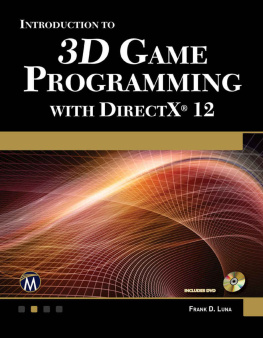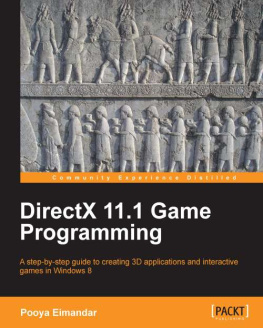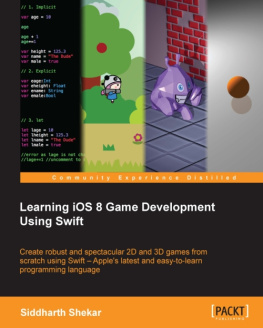Introduction to
3D G AME P ROGRAMMING
WITH D IRECT X 12
LICENSE, DISCLAIMER OF LIABILITY, AND LIMITED WARRANTY
By purchasing or using this book (the Work), you agree that this license grants permission to use the contents contained herein, but does not give you the right of ownership to any of the textual content in the book or ownership to any of the information or products contained in it. This license does not permit uploading of the Work onto the Internet or on a network (of any kind) without the written consent of the Publisher. Duplication or dissemination of any text, code, simulations, images, etc. contained herein is limited to and subject to licensing terms for the respective products, and permission must be obtained from the Publisher or the owner of the content, etc., in order to reproduce or network any portion of the textual material (in any media) that is contained in the Work.
M ERCURY L EARNING AND I NFORMATION (MLI or the Publisher) and anyone involved in the creation, writing, or production of the companion disc, accompanying algorithms, code, or computer programs (the software), and any accompanying Web site or software of the Work, cannot and do not warrant the performance or results that might be obtained by using the contents of the Work. The author, developers, and the Publisher have used their best efforts to insure the accuracy and functionality of the textual material and/or programs contained in this package; we, however, make no warranty of any kind, express or implied, regarding the performance of these contents or programs. The Work is sold as is without warranty (except for defective materials used in manufacturing the book or due to faulty workmanship).
The author, developers, and the publisher of any accompanying content, and anyone involved in the composition, production, and manufacturing of this work will not be liable for damages of any kind arising out of the use of (or the inability to use) the algorithms, source code, computer programs, or textual material contained in this publication. This includes, but is not limited to, loss of revenue or profit, or other incidental, physical, or consequential damages arising out of the use of this Work.
The sole remedy in the event of a claim of any kind is expressly limited to replacement of the book, and only at the discretion of the Publisher. The use of implied warranty and certain exclusions vary from state to state, and might not apply to the purchaser of this product.
Companion disc files are available for download from the publisher by writing to info@merclearning.com.
Introduction to
3D G AME P ROGRAMMING
WITH D IRECT X 12
Frank D. Luna

Copyright 2016 by M ERCURY L EARNING AND I NFORMATION LLC. All rights reserved.
This publication, portions of it, or any accompanying software may not be reproduced in any way, stored in a retrieval system of any type, or transmitted by any means, media, electronic display or mechanical display, including, but not limited to, photocopy, recording, Internet postings, or scanning, without prior permission in writing from the publisher.
Publisher: David Pallai
M ERCURY L EARNING AND I NFORMATION
22841 Quicksilver Drive
Dulles, VA 20166
info@merclearning.com
www.merclearning.com
(800) 232-0223
Frank D. Luna. Introduction to 3D GAME PROGRAMMING WITH DIRECTX 12
ISBN: 978-1-942270-06-5
The publisher recognizes and respects all marks used by companies, manufacturers, and developers as a means to distinguish their products. All brand names and product names mentioned in this book are trademarks or service marks of their respective companies. Any omission or misuse (of any kind) of service marks or trademarks, etc. is not an attempt to infringe on the property of others.
Library of Congress Control Number: 2015957713
161718321 This book is printed on acid-free paper.
Our titles are available for adoption, license, or bulk purchase by institutions, corporations, etc.
For additional information, please contact the Customer Service Dept. at 800-232-0223(toll free).
All of our titles are available in digital format at authorcloudware.com and other digital vendors. Companion files for this title are available by contacting info@merclearning.com. The sole obligation of M ERCURY L EARNING AND I NFORMATION to the purchaser is to replace the book or disc, based on defective materials or faulty workmanship, but not based on the operation or functionality of the product.
To my nieces and nephews,
Marrick, Hans, Max, Anna, Augustus, Presley, and Elyse
C ONTENTS
I would like to thank Rod Lopez, Jim Leiterman, Hanley Leung, Rick Falck, Tybon Wu, Tuomas Sandroos, Eric Sandegren, Jay Tennant and William Goschnick for reviewing earlier editions of the book. I want to thank Tyler Drinkard for building some of the 3D models and textures used in some of the demo programs available on the books website. I also want to thank Dale E. La Force, Adam Hoult, Gary Simmons, James Lambers, and William Chin for their assistance in the past. In addition, I want to thank Matt Sandy for getting me on the DirectX 12 beta, and the rest of the DirectX team that helped answer questions for beta users. Finally, I want to thank the staff at Mercury Learning and Information, in particular, David Pallai, the publisher, and Jennifer Blaney, who guided the book through production.
Direct3D 12 is a rendering library for writing high-performance 3D graphics applications using modern graphics hardware on various Windows 10 platforms (Windows Desktop, Mobile, and Xbox One). Direct3D is a low-level library in the sense that its application programming interface (API) closely models the underlying graphics hardware it controls. The predominant consumer of Direct3D is the games industry, where higher level rendering engines are built on top of Direct3D. However, other industries need high performance interactive 3D graphics as well, such as medical and scientific visualization and architectural walkthrough. In addition, with every new PC being equipped with a modern graphics card, non-3D applications are beginning to take advantage of the GPU (graphics processing unit) to offload work to the graphics card for intensive calculations; this is known as general purpose GPU computing , and Direct3D provides the compute shader API for writing general purpose GPU programs. Although Direct3D 12 is usually programmed from native C++, the SharpDX team (http://sharpdx.org/) is working on .NET wrappers so that you can access this powerful 3D graphics API from managed applications.
This book presents an introduction to programming interactive computer graphics, with an emphasis on game development, using Direct3D 12. It teaches the fundamentals of Direct3D and shader programming, after which the reader will be prepared to go on and learn more advanced techniques. The book is divided into three main parts. Part I explains the mathematical tools that will be used throughout this book. Part II shows how to implement fundamental tasks in Direct3D, such as initialization; defining 3D geometry; setting up cameras; creating vertex, pixel, geometry, and compute shaders; lighting; texturing; blending; stenciling; and tessellation. Part III is largely about applying Direct3D to implement a variety of interesting techniques and special effects, such as working with animated character meshes, picking, environment mapping, normal mapping, real-time shadows, and ambient occlusion.
For the beginner, this book is best read front to back. The chapters have been organized so that the difficulty increases progressively with each chapter. In this way, there are no sudden jumps in complexity leaving the reader lost. In general, for a particular chapter, we will use the techniques and concepts previously developed. Therefore, it is important that you have mastered the material of a chapter before continuing. Experienced readers can pick the chapters of interest.
Next page








